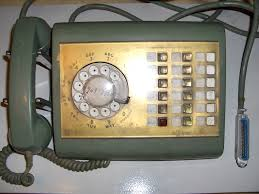
The original APO system was a key based phone system. A key
based phone system has multiple outside lines going to the phones.
The following figure is a phone from an old system showing
the largish cable that has all the phone lines in it and the
mechanical switches for selecting a phone line.

The modern IP PBX systems use a network cable and data to handle
phone calls from SIP phones. IP PBX means a PBX system using
the internet to manage phone calls. The difference between
the old parallel phone lines and switches is now software and a
network. There is no concept of individual lines to a
phone. The PBX is now based on the idea of a call between
two points, and the call can be parked and picked up by another
point. When the call is picked up, the data flows. The
outside lines can be the old lines converted to data streams, and
outside lines can also be internet SIP trunks that have 1 or more
data streams attached to it. At the SIP provider, phone
numbers can be purchased and attached to the trunk, too.
When a call comes into a number on the trunk, the available data
path is used to connect the call to the PBX. If there are no
data paths, then the called number is not available. The
call is transferred to a fallback number if available. For
APO, there are 8 lines in, which is 8 data paths. A possible
configuration is a number of local lines, and then a few long
distance lines on a SIP trunk.
The new IP PBX is the current state of the art for PBX
systems. The buzz words are SIP, SIP phones, SIP trunks for
telephone lines, and IP PBX systems based on Asterisk, an
open source project supported by SIP telecom companies.
The advantage of an IP PBX system based on Asterisk and SIP is: